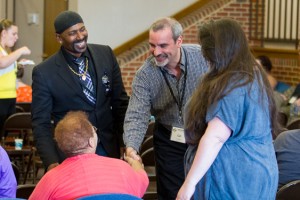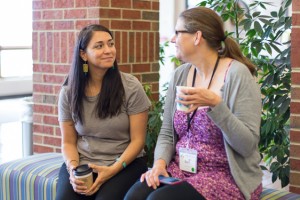To the outsider, the June 15-18 Restorative Justice in Motion conference at Eastern Mennonite University may have looked like any other summer gathering of intellectuals, ready to share, network and learn.
Yet to overhear bits of conversation was to immediately be confronted by the difficult and inherent tensions of restorative justice, which emphasizes repairing harms of all those involved.
It’s best to describe those tensions in questions, notes conference organizer Carl Stauffer, co-director of the Zehr Institute of Restorative Justice: Is it a social movement that encourages whole-systems change or a solidifying field of practice? What does it mean if those facilitating the process operate from a place of white privilege? Where are its efficacious impacts: in creating restorative cities, in transitional justice processes within warring countries, in trauma healing, in prisons?

“I think people were ready to converse in ways they hadn’t had the space to before,” said Soula Pefkaros, a doctoral student and 2010 graduate of the Center for Justice and Peacebuilding, who worked on the conference’s organization and format.
Themes and challenges
The conference is the second event within a larger three-year project to map the field of restorative justice. In summer 2015, 36 people representing a broad diversity of experiences, practices, backgrounds and identities, met for five days at EMU to discuss the future of the field. Renowned practitioners joined with an equal proportion bringing diverse and often-unheard perspectives.
Last week’s conference drew an even wider group of approximately 170 participants, all of whom use restorative justice practices in many settings and with many demographics, as evidenced by an incomplete list of programs represented at the conference:
- California Conference for Equality and Justice;
- Restorative Justice for Oakland Youth;
- Coming To the Table, which focuses on healing historic harms of racism;
- Campus PRISM, an acronym for a higher education model of Promoting Restorative Initiatives for Sexual Misconduct;
- Common Justice, offering alternative-to-incarceration programs for youth ages 18-24 convicted of serious and violent felonies and their victims; and
- restorative city movements, represented by groups from Washington D.C., Harrisonburg and Whangai, New Zealand.
Sessions were developed not only around settings where restorative justice principles can be practiced, but also around themes and challenges discussed in the consultation.

Many practitioners, for example, disagree whether restorative justice is a social movement or an emerging social service field. Stauffer, in his keynote address, urged participants “to hold together” this paradox between theory and practice. He also pointed out that “racial justice, identify, power, privilege and diversity will be key themes of social change.”
Building inclusivity and diversity
Pefkaros commented these key themes were ones that conference organizers sought to address in their call for presenters. “One conclusion from last summer’s consultation is that practitioners are often working at the intersections of race, power, privilege and identity, yet many haven’t really addressed those difficult topics,” Pefkaros said. “Those conversations hadn’t happened in any of these broad RJ meeting spaces and folks were expressing a giant question about how to do this work without having those conversations.”
Creating an inclusive and diverse space was also an important goal of the conference, she added. “Far too often conferences and other spaces are only accessible to a privileged few, often white people working in well-funded non-profits and institutions. We offered scholarships and encouraged youth and people of color to be an integral part of this conference.”
Another emphasis was offering engagement opportunities across the learning modalities. Indeed the conference did just that, providing venues for “banker-style” seminars with linear seating arrangements and more organic explorations created by circles processes, storytelling sessions and experiential learning environments.
In process-oriented workshops, tensions sometimes arose, Pefkaros acknowledged. “We almost expected that,” she said. “At the same time as it’s uncomfortable when that happens, these are people who are living and working in those tensions. If it didn’t happen, I’m not sure we would be creating the space we set out to. I’m sure there are those who aren’t completely satisfied with how this conference has gone and there are others who feel like we’ve made some breakthroughs.”
By the end of Thursday’s scheduled sessions, a few “flare-ups” and “hot moments” had occurred. Conference organizers addressed concerns and grievances with the help of peacemaking circles expert Kay Pranis, a conference participant. She hosted a three-hour-plus circle late into the evening.
Yet many participants left invigorated by the conversations and the shared vision of creating a more equitable society.
“The conference rocked my world view, challenged me in very deep ways, and above all else gave me hope,” said Josh Bacon, associate dean of students and director of Student Accountability and Restorative Practices at James Madison University. “Connecting with peacebuilders from around the world who are open to challenging and learning from each other is energizing. This group is not afraid to address the serious, confrontational, and deep issues that affect our work. I think in this spirit we all know how important this works is and the gravity of the issues facing our world.

“To paraphrase a keynote speaker, we are not willing to accept diluted justice for the sake of harmony. It takes a special group of people to come together, in a special way, and in a special place to do that.”
‘I’ll be doing RJ for the rest of my life’
At least one participant had made up his mind about the “RJ as social movement or social practice” question. Marqees “Sky” Banks learned about restorative justice after he had a fight with a fellow student a few years ago at Augustus F. Hawkins High School in South Los Angeles. That’s where Joseph Luciani, a EMU Center for Justice and Peacebuilding graduate, is restorative justice coordinator.
Since participating in a circle process after an on-campus fight, Banks became a believer in the power of restorative justice principles to change people’s lives, to help them share and show love to others. “It’s about love first, to me,” he said. “I think you have to start with RJ on a more interpersonal level, then it grows into a movement. You live it first.”
Banks, who is contemplating University of Southern California, UC Berkeley and a few other options, has been a counselor at the Building Bridges summer camps sponsored by California Conference of Equality and Justice and he loves bringing people together to dialogue and bond and learn to respect each other.
“I don’t need to make it a job,” he says. “I’ll be doing RJ for the rest of my life!”
